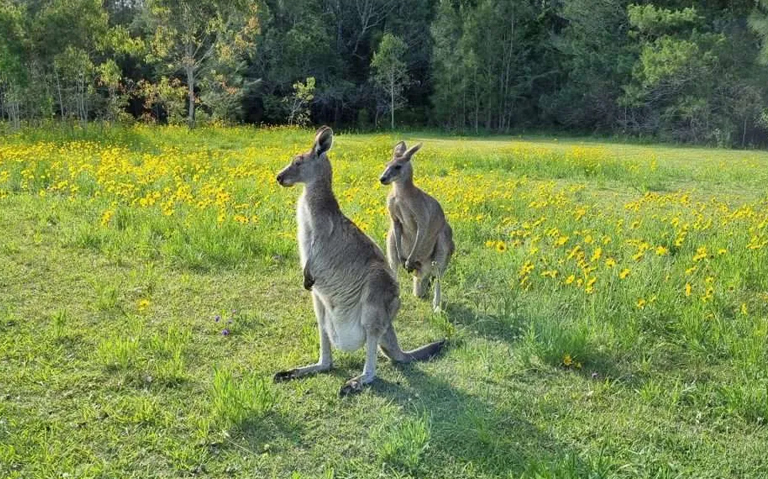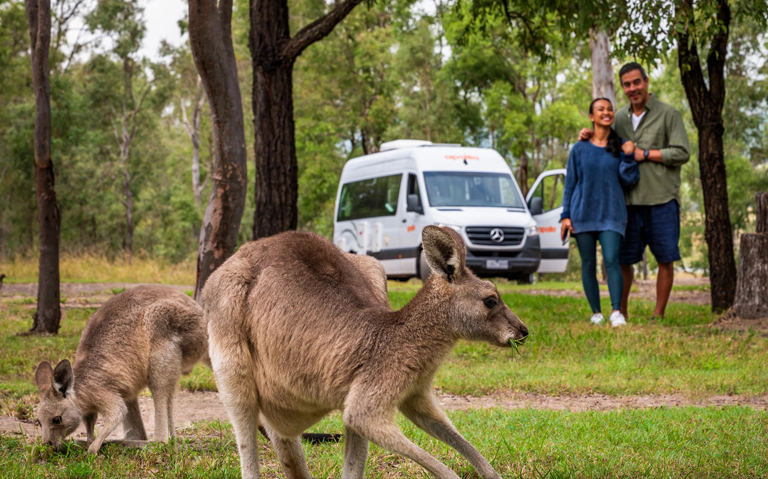Australia is a great place to see these iconic species of wildlife roaming free in the wild. If you’re dreaming of seeing kangaroos, koalas, and wombats on your next visit, here’s where you can do so with the best odds—and advice for a safe, ethical and unforgettable experience.
The Ultimate Guide to Seeing Kangaroos, Koalas & Wombats in the Wild
Kangaroos: Best Places to Spot Them

Kangaroos are often found on open grasslands and national parks, and sometimes on beaches.
In Australia, try these places:
- Murramarang National Park (NSW): The Pebbly Beach area is well-known for kangaroos roaming freely on the beach.
- Kangaroo Valley (NSW near Booderee National Park): Very reliable for frequent wild kangaroo sightings at any time of day; especially at dawn and dusk.
- Cape Hillsborough (QLD): Famous for tourists visiting at sunrise and finding kangaroos and wallabies on the sand.
- Lucky Bay, Esperance (WA): Kangaroos are frequently lounging around on the whitest sand beaches in Australia, often near the bushland or seaweed.
- Namadgi National Park, ACT (near Canberra): Great opportunity close to the capital with a healthy Eastern Grey kangaroo population in open grassy areas.
- Great Ocean Road (VIC): Check the areas around Anglesea and the Tower Hill Wildlife Reserve which are known for healthy kangaroo populations.
A few quick tips:
- Kangaroos are most active during early mornings and late afternoons, so these are the best times to visit.
- Don’t make sudden movements when you spot them. Maintain a safe distance and watch without disturbing.
- Never feed wild kangaroos, as human food can make them sick and encourage aggressive behavior.

Koalas: Best Wild Sighting Spots
Koalas are more arboreal, and harder to spot than kangaroos, but there are easy places to see them in the wild.
In Australia, check these locations:
- Raymond Island (VIC): One of Australia’s best koala hotspots, especially the Koala Trail walking track, where sightings are almost guaranteed.
- Port Stephens, Tilligerry Habitat (NSW): A special reserve for koala spotting in the trees, with community-based eco-tourism.
- Kangaroo Island (SA): Especially the Flinders Chase National Park area; koala populations are large in the native forests.
- Great Ocean Road (VIC): Stop at Kennett River and Cape Otway for prime roadside viewing of koalas in eucalypt trees. Drive slowly and look up.
- Yanchep National Park (WA): Known for resident koalas in large natural enclosures, though they are not native to this area.
A few tips to make your spotting:
- Always look up; koalas take naps in the eucalypt branches.
- Most active at dawn and dusk, but these slow-moving creatures are often spotted napping any time of day.
- Move slowly and avoid loud noises. Koalas have a strong fear of humans and can easily be spooked.
- Use binoculars or a camera with a zoom lens for a better view without disturbing them.
Wombats: Top Places for Wild Encounters
Wombats are found in forested and open grassy areas, and are most common in the southeast.
Locations with proven wombat sightings include:
- Kangaroo Valley (NSW): The Bendeela Recreation Area in particular is known for wombats grazing at dusk.
- Maria Island (TAS): Widely considered the best place in Australia for wild wombat spotting, especially around Darlington and along the walking trails. They are often unfazed by human presence, but still keep your distance.
- Cradle Mountain & Ronny Creek (TAS): Often spotted grazing in the open fields and along the boardwalk areas.
- Wilsons Promontory National Park (VIC): Frequent sightings around the Tidal River area and on the walking trails.
- Namadgi National Park (ACT): Good chance to see wombats along creek crossings and in the open grassy clearings.
- Booderee National Park (NSW): Occasionally spotted wandering around near campsites and walking trails.
A few tips on your wombat watching:
- Wombats are generally nocturnal, so visit in the dusk for best odds of a sighting. In colder, wetter weather, they may be active throughout the day.
- Never approach or feed wombats; keep your distance and respect their burrows and natural behaviour.
- Drive slowly in areas they may inhabit, particularly at night.
Wildlife Sighting Table
| Animal | Best Spot(s) | State | Best Time |
|---|---|---|---|
| Kangaroo | Pebbly Beach (Murramarang NP), Kangaroo Valley | NSW | Dawn/Dusk |
| Koala | Raymond Island, Tilligerry Habitat Reserve, Kangaroo Island | VIC, NSW, SA | Dawn/Dusk |
| Wombat | Kangaroo Valley (Bendeela), Maria Island, Cradle Mountain | NSW, TAS, VIC | Dusk/Evening |
Enjoying Responsible Wildlife Encounters
Remember to respect your wild neighbours.
- Keep your distance: Don’t touch or feed wild animals. Observing from a safe distance ensures both your safety and their well-being.
- Stick to the walking trails: Protect their habitat and stay safe from danger. Do not chase or disturb animals.
- Respect road rules: Many animals are run over at dawn and dusk, so watch out and drive slowly, especially in designated wildlife areas.
- Leave no trace: Take your rubbish away and keep your visit low impact. This includes not leaving food scraps, which can attract animals and lead to unnatural dependencies.
FAQs
1. Will I see these animals in Sydney’s city parks?
Wild kangaroos, koalas, and wombats are very rare to find in inner-city parks. Stick to the national parks or nature reserves listed above for an authentic wild sighting experience.
2. Are there guided tours to increase my chances?
Yes, many of the parks and local operators offer tours with experienced guides who know the best wildlife hotspots. For example, Kangaroo Valley Adventure Company offers wildlife viewing tours.
3. What’s the best season to see wildlife?
Cooler months can be more favourable for wombats (they’re more active during the day), but kangaroos and koalas are visible year-round. Dawn and dusk are generally the best windows for seeing all three species.
4. Can I camp in these wildlife areas?
Many of the featured areas, such as Kangaroo Valley or Maria Island, have campgrounds or bush camping opportunities—just check signs, conditions, and booking requirements (if any) beforehand.
So there you have it: Australia’s best wild spots for kangaroos, koalas and wombats! Now go plan your wildlife road trip adventure, follow the local rules, and make some lifelong memories.
More Wildlife Moments:
- Best places to see wild kangaroos and koalas in Australia
- The best spots to see wild kangaroos on beaches in Australia
- How to choose a koala sanctuary in Australia
- National parks for best kangaroo, koala and wombat wildlife sightings
- Koala sighting tours near Sydney
- The best koala and kangaroo spotting tours and wildlife encounters around Sydney
- Are kangaroos and koalas dangerous to humans?
- Where can I go to watch kangaroos and koalas in Australia?
- Where to see wallabies, kangaroos, koalas and wombats in the wild
- How to see kangaroos in the wild in Australia
- Kangaroos and koalas: which areas and national parks in Australia have wild kangaroos, koalas and wombats?